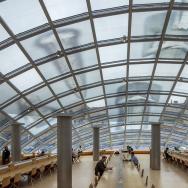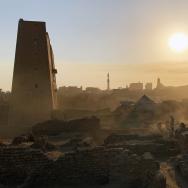Walk around a corner in the Oriental Institute Museum, and you’ll see a 2,900-year-old stone relief fragment showing the head of an Assyrian king. What’s even more striking is everything surrounding the artifact: outstretched arms made of brown newspaper ads, a bow composed of blue cracker wrappers and a gold-foiled sword hanging from the hip. Those dazzling colors represent what was destroyed four years ago by the Islamic State, surviving only in memory and imagination.
Michael Rakowitz’s sculptures might not resemble ghosts—at least, not in the way most would expect. But that’s exactly how the acclaimed artist sees his artifacts, reimagined from an array of Middle Eastern newspapers and Iraqi food packaging.
Since 2007, the Iraqi American artist has worked to recreate the thousands of objects consumed by armed conflict, invasion and looting. Installed at the University of Chicago’s Oriental Institute is one recent example: a demolished palace relief panel, reconjured in the vivid hues of household detritus.
“I describe these things as ghosts, as a kind of spectral presence—not a reconstruction, but a reappearance,” Rakowitz said. “They can haunt, but for the person that misses the object that became the ghost, they can also reassure.”
Installed as part of the OI’s 100th anniversary celebration, his “reappearance” seeks to do both. An award-winning artist known around the world for his interdisciplinary practice, Rakowitz’s projects explore the personal, the collective and the political. His ongoing series, The invisible enemy should not exist, serves as a reminder of the casualties of war, yet also offers comfort to the diaspora scattered from their homeland.
Juxtaposed with the surviving piece of the original panel from the Northwest Palace of the Assyrian king Ashurnasirpal II at Nimrud, Rakowitz’s work in the OI Museum highlights what he called “a temporary moment of realignment.” Something has been resurrected, but the wound of warfare remains visible.
Measuring 7.6 by 7 feet, the installation incorporates a stone fragment in the OI collection that was received by exchange with the British Museum in 1974, one depicting the crown, face, hair and beard of the Assyrian king. Across from the king stands an assistant in the midst of a libation ritual, dressed by Rakowitz in pink and teal. The spot where the assistant’s head should be is papier-mâchéd in black and gray, marking the existence of another fragment held in London.
“By evoking what has been lost of this panel, Michael juxtaposes the ancient artifact with its contemporary context,” said Christopher Woods, director of the OI and the John A. Wilson Professor of Sumerology. “We’re delighted that his collaboration for our centennial makes our visitors reflect upon the cultural heritage issues at stake today.”
Standing alongside other artifacts in the museum’s Dr. Norman Solhkhah Family Assyrian Empire Gallery, the piece was produced for the OI’s centennial, which celebrates the institute’s century of excavations and field projects in the Middle East and its groundbreaking research on the earliest civilizations. On display at the OI Museum through the 2019–20 academic year, the panel’s colors also hint at the original appearance of the palace relief, which would have been painted in bold colors, including black, red, blue and white.
“We’re thrilled that Michael Rakowitz, a major force in contemporary art, has continued his longstanding collaboration with us,” said Jean M. Evans, the OI Museum’s chief curator and deputy director. “Visitors walking through our galleries will not only experience a century’s worth of excavations, but will also see how these artifacts need to be protected and cared for still today.”
The panel is the latest product of the partnership between the OI and Rakowitz, a professor of art theory and practice at Northwestern University. In 2005, he began to rely on the OI’s illustrated database of archaeological objects from the Iraq Museum, which was launched shortly after the fall of Baghdad in April 2003. Following the looting of the Iraq Museum that same month, the database preserved a detailed “snapshot” of the cultural patrimony lost to war.
“It was either Interpol or the OI that had any of this information,” Rakowitz said.
He also values his relationship with the OI because of the institution’s willingness to explore what he called the “uncomfortable Möbius strip” of archaeological history—the ways in which objects found their way to museums through the black or gray markets, or the ways in which demand for Middle Eastern art is not always coupled with equal interest in the welfare of the region’s people.
“Research should be driven by our respect and curiosity for one another’s cultures,” Rakowitz said. “But we know the foundation for a lot of that was not always about equitable exchange. Things were extracted forcibly from a lot of places and brought to museums in the west.
“It creates a kind of double bind—a sweet and sour understanding of the ways in which history has unfolded when it comes to archaeology. With the OI, those nuances do get discussed.”
The invisible enemy should not exist can feel grand at times, both in scale and purpose. Another sculpture in the series looms in London’s Trafalgar Square, a 14-foot lamassu—a winged bull deity—pointing southeast to the British Parliament and to what was once the ancient Assyrian capital city of Nineveh. But Rakowitz’s art is also rooted in the everyday, the quotidian.
More than a decade ago, he reopened Davisons & Co., the import and export company once run by his grandfather Nissim Isaac David, an Iraqi Jew who fled his country in 1946. In doing so, he found himself surrounded by colorful packages—date tins and cookies that had rebranded themselves, hiding their Iraqi origin to avoid sanctions. They became reminders of his own life, both in his upbringing and the meals he now cooks for his household.
For Rakowitz, as well as countless other immigrant and refugee families, the “alchemy of the kitchen” remains one of the strongest channels for cultural transmission from one generation to another.
“Those moments are accompanied by a certain amount of joy,” he said. “To be able to make one’s food from that place, there’s a certain amount of steadfastness that comes with that, if not hope. It’s about the continuation of those populations that do end up elsewhere. There is still survival. Things do go on.”
Since its founding in 1919, the OI has conducted field-defining research across the Middle East, including excavations and field projects, linguistic research deciphering ancient languages, creating comprehensive dictionaries, reconstructing the histories, literatures and religions of long-lost civilizations, and preserving the region’s imperiled cultural heritage. Much of this research is on display at the OI Museum, located on the UChicago campus and home to the largest collection of ancient Middle Eastern artifacts in the United States with 350,000 objects.
As part of the centennial celebrations, the OI has completed a comprehensive reinstallation of its galleries, with some 500 artifacts from the collection that have never before been on permanent display. Special events as well as artist collaborations are planned throughout the 2019–2020 academic year. A full listing is available at the centennial website.

